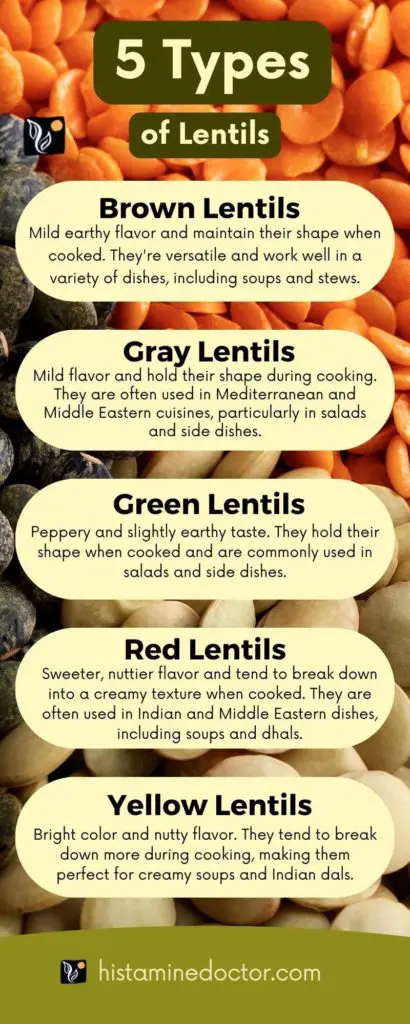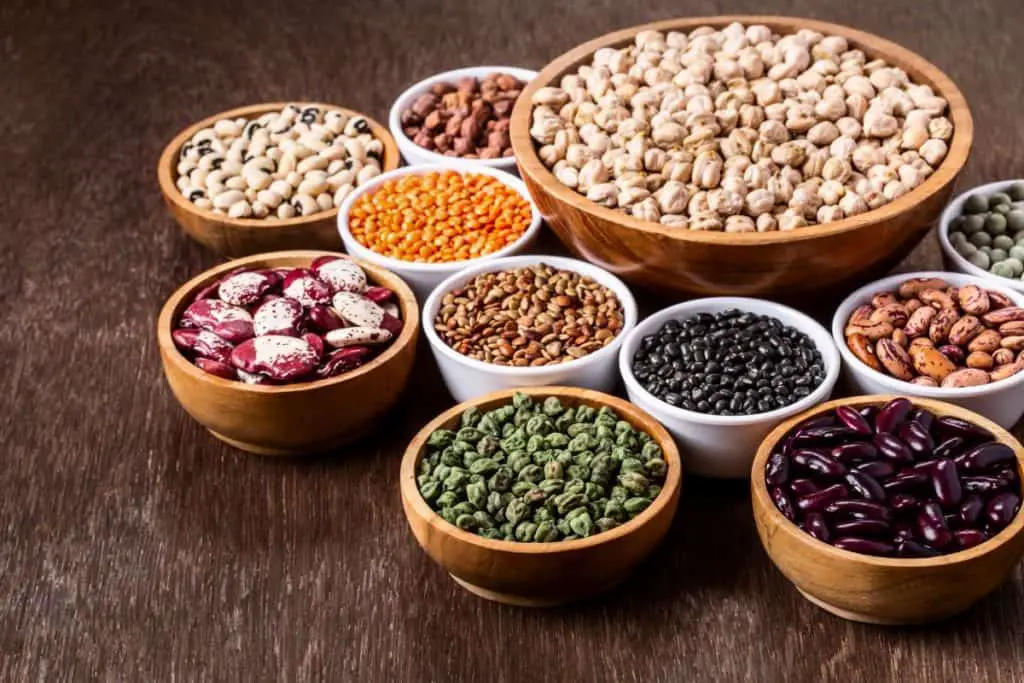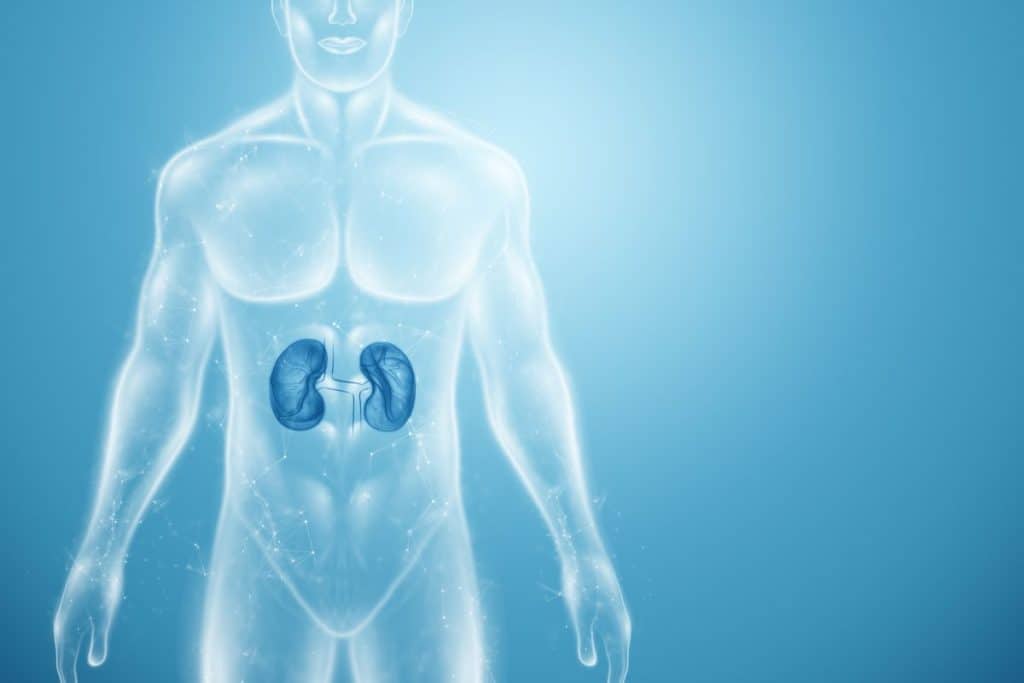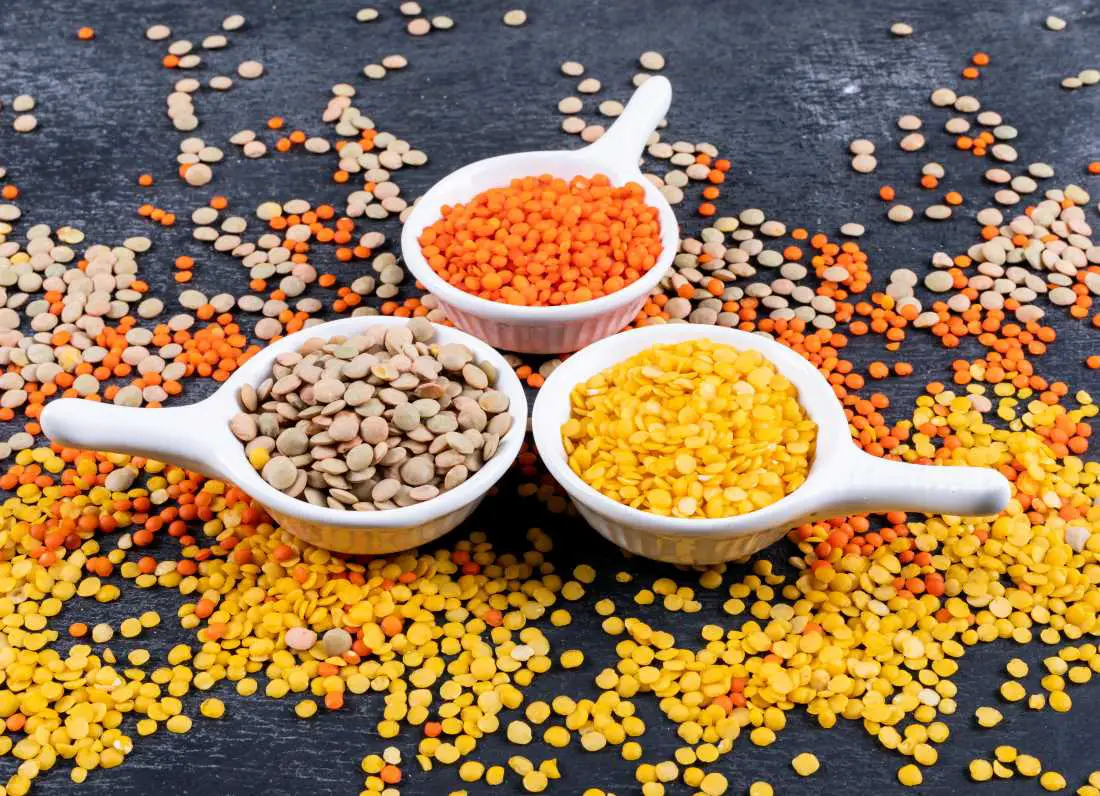If you have histamine intolerance, you might wonder whether it’s safe to eat lentils and whether they’re likely to trigger histamine intolerance symptoms. Are lentils high in histamine?
Lentils are popular as a plant-based source of protein, and they’re also an excellent source of fiber. If you’re trying to reduce the amount of meat in your diet, lentils are a versatile food high in plant protein.
But, as you know, you have to reduce your exposure to high-histamine foods and foods that trigger histamine release when you have histamine intolerance, also known as histamine sensitivity.
With this condition, your body lacks sufficient diamine oxidase, one of the enzymes that breaks down histamine, to completely clear it from your body.
Without enough diamine oxidase, histamine stays in your system too long and may trigger histamine intolerance symptoms. That’s what you want to avoid!
You also want to avoid foods that block the activity of diamine oxidase. The symptoms of histamine intolerance vary.
Some people experience symptoms similar to seasonal allergies, nasal stuffiness, headache, or a runny nose.
Digestive issues are also common. One study found that common digestive symptoms people experience with histamine sensitivity include: (1)
- Diarrhea
- Abdominal pain
- Constipation
- Feeling unusually full after a meal
The best way to keep histamine intolerance symptoms under control is to avoid foods that increase your body’s histamine burden. Are lentils high in histamine?

Are Lentils High in Histamine? What You Should Know
Are lentils high in histamine? Lentils are part of the legume family, a family of plant-based foods that includes peanuts, lentils, and beans.
Lentils are an excellent source of plant-based protein, making them the go-to choice for individuals adhering to vegetarian or vegan diets.
Plus, they contain essential nutrients such as B-vitamins, magnesium, potassium, and iron. They’re also rich in fiber, a dietary component that supports healthy digestion and bowel function.

Does the Type of Lentil Affect Its Histamine Content?
Lentils come in a variety of colors. The most common lentils you buy at the grocery store are brown, gray, or yellow in color. You can also buy green lentils and red lentils.
Each type of lentil has subtle differences in taste or texture. For example, darker lentils, brown, black, green, and gray, have an earthy taste. In contrast, red lentils are sweeter with a slight nutty flavor.
Although lentils are not known to be high in histamine, they can contain other biogenic amines. For example, a study found lentils contain spermidine. (16)
Why is spermidine a concern? A study found that other biogenic amines, such as spermidine, can interfere with the breakdown of histamine. So, it may indirectly elevate your histamine level by slowing down histamine’s elimination. (15)
Therefore, lentils are a “cautionary” food. Most people can tolerate them in moderation, but individual responses may vary.
Are Red Lentils High Histamine?
If you have histamine intolerance, red lentils may be a better choice than brown or gray lentils. Red lentils contain higher levels of flavonoids, compounds with antioxidant and anti-inflammatory activity, compared to brown or gray lentils.
Consuming more anti-inflammatory foods may be beneficial if you have histamine intolerance.(14) In terms of total antioxidant activity, red lentils contained the most, while brown lentils contained the least. (14)

Should You Sprout Lentils?
More people are into sprouting these days, as sprouting increases bioavailability of B-vitamins and vitamin C. Sprouting also reduces phytic acid.
Lowering phytic acid is beneficial, because phytic acid makes it harder for your body to absorb some minerals, including calcium, zinc, and iron. (4)
Although sprouting has benefits, it won’t remove biogenic amines. A study found that if you sprout lentils, boiling them only eliminates a small quantity of the biogenic amines, not enough to make a meaningful difference. (3)
So, avoid sprouted lentils even if you boil them, as it’s not effective for removing amines, like tyramine and others that can have some of the same effects as histamine since histamine is also a biogenic amine.

Lentils Are High in Lectins
Beyond the histamine content of lentils, they’re also high in lectins, proteins on the surface of certain plant-based foods. Lentils are one of the richest sources of lectins, but they’re not the only ones.
According to Harvard Health, beans, peas, peanuts, and whole grains also top the list of lectin-rich foods. (6)
Why are there concerns in some circles about lectins? These proteins reduce the absorption of some minerals, particularly zinc, iron, and calcium, by attaching to cells in the digestive tract.
One theory is that if lectins attach to cells for a long time, it could trigger an autoimmune reaction and inflammation, but this hasn’t been proven conclusively.
Still, there is evidence that lectins play a role in certain inflammatory conditions, like rheumatoid arthritis. (8) It may turn out that lectins are problematic for people with autoimmune conditions, too.
Anecdotally, some people say that lectin-rich foods worsen their symptoms.
On the plus side, foods that contain lectins, like lentils, are nutrient dense and contain phytonutrients with anti-inflammatory activity. Most of the harm of lectins comes from laboratory studies where researchers exposed cells to large quantities of lectins from raw wheat.
In the study, raw wheat caused histamine release.(10) But it’s doubtful that the cells in your intestinal tract would ever be exposed to such large quantities of lectins by eating a food, such as cooked lentils.

Reducing Lectins in Lentils
Is there a way to reduce lectins in lentils? Yes, but you’ll need to prepare them yourself and not use canned lentils. You can lower the lectin content of lentils by soaking them in water for 24 hours, and then cooking them to a high temperature by boiling. (7)
Since lectins are on the surface of lentils, it’s easy to inactivate them with water and heat.
Well soaked and cooked lectins should not increase the risk of inflammatory symptoms or significantly interfere with the absorption of minerals. Still, if lectin-rich foods, like lentils, worsen your histamine intolerance symptoms, avoid them. You can find out how they affect you by keeping a food diary.
Keeping a food diary is one of the most important things you can do if you have histamine intolerance. You’re unique among other individuals with histamine intolerance, and your tolerance to certain foods may differ too.
You’ll discover exactly how your body responds to foods, like lentils, by closely tracking your symptoms through journaling. Also, find out about histamines in black beans.

Lentils Also Contain Oxalates
Lentils contain other compounds called oxalates. (11) This makes consuming large quantities off-limits for people with a history of calcium-oxalate kidney stones. (12) But there are other concerns about oxalates, and some indirectly relate to histamine intolerance.
Plus, there are reports of people with histamine sensitivity responding poorly to oxalate-rich foods, like lentils, although it’s not necessarily oxalates that trigger the symptoms.
Why would oxalates be a problem with histamine intolerance? Some people, especially those with poor gut health, seem to have problems eliminating oxalates. The thought is that, in some people, oxalates build up, activate the immune system, and cause inflammation.
Where there’s inflammation, there’s histamine release. That’s why some sites recommend limiting dietary oxalates for people with histamine intolerance.
However, the oxalate-histamine intolerance connection isn’t proven, and, unless you have a history of kidney stones, most healthcare providers don’t advise limiting them. But since a number of people with histamine intolerance also have gut health issues,
I wouldn’t recommend making them a large part of your diet. If you develop symptoms after consuming foods high in oxalates, it’s best to remove oxalate-rich foods from your diet.
Find out whether green beans are high in histamine.
Take-Home Points
- Lentils are “cautionary” and may worsen histamine intolerance symptoms for some people but some people tolerate them without problems.
- Lentils contain other biogenic amines, oxalates, and lectins. Depending on the individual, any of these components could be problematic
- You can reduce some of these components in lentils by soaking them for 12 to 24 hours. Then eliminate the water and boil them.
- If you have a history of kidney stones, avoid oxalate-rich foods like lentils
- If you have gut issues, limit lentils too.
- Use the freshest lentils and use them quickly to avoid bacterial contamination that could increase their histamine content.
References:
- Schnedl WJ, Lackner S, Enko D, Schenk M, Holasek SJ, Mangge H. Evaluation of symptoms and symptom combinations in histamine intolerance. Intest Res. 2019 Jul;17(3):427-433. doi: 10.5217/ir.2018.00152. Epub 2019 Mar 7. PMID: 30836736; PMCID: PMC6667364.
- Naila A, Flint S, Fletcher G, Bremer P, Meerdink G. Control of biogenic amines in food–existing and emerging approaches. J Food Sci. 2010 Sep;75(7):R139-50. doi: 10.1111/j.1750-3841.2010.01774.x. PMID: 21535566; PMCID: PMC2995314. https://pubmed.ncbi.nlm.nih.gov/21535566/
- Shalaby AR. Changes in biogenic amines in mature and germinating legume seeds and their behavior during cooking. Nahrung. 2000 Feb;44(1):23-7. doi: 10.1002/(SICI)1521-3803(20000101)44:1<23::AID-FOOD23>3.0.CO;2-B. PMID: 10702995. Harvard T.H. Chan School of Public Health. “Sprouted Lentils” https://www.hsph.harvard.edu/nutritionsource/sprouted-lentils/
- Vojdani A. Lectins, agglutinins, and their roles in autoimmune reactivities. Altern Ther Health Med. 2015;21 Suppl 1:46-51. PMID: 25599185.
- “Lectins | The Nutrition Source | Harvard T.H. Chan School ….” https://www.hsph.harvard.edu/nutritionsource/anti-nutrients/lectins/.
- Petroski W, Minich DM. Is There Such a Thing as “Anti-Nutrients”? A Narrative Review of Perceived Problematic Plant Compounds. Nutrients. 2020 Oct;12(10):2929.
- Freed DL. Do dietary lectins cause disease? BMJ. 1999 Apr 17;318(7190):1023-4. doi: 10.1136/bmj.318.7190.1023. PMID: 10205084; PMCID: PMC1115436.
- Chai W, Liebman M. Effect of different cooking methods on vegetable oxalate content. J Agric Food Chem. 2005 Apr 20;53(8):3027-30. doi: 10.1021/jf048128d. PMID: 15826055.
- Tufts Health and Nutrition Newsletter. “Health Harms of Lectins: Hype or Paradox?”
- “Are Lentils High In Oxalates? – Food FAQ.” https://foodfaq.org/are-lentils-high-in-oxalates/.
- “Effect of mineral water containing calcium and magnesium ….” https://pubmed.ncbi.nlm.nih.gov/9096270/.
- Mockus E, Egle Zokaityte, Vytaute Starkute, et al. Influence of different lactic acid bacteria strains and milling process on the solid-state fermented green and red lentils (Lens culinaris L.) properties including gamma-aminobutyric acid formation. Frontiers in Nutrition. 2023;10. doi:https://doi.org/10.3389/fnut.2023.1118710. Influence of different lactic acid bacteria strains and milling process on the solid-state fermented green and red lentils ( Lens culinaris L.) properties including gamma-aminobutyric acid formation – PubMed (nih.gov)
- Xia M, Li M, de Souza TSP, Barrow C, Dunshea FR, Suleria HAR. LC-ESI-QTOF-MS2 Characterization of Phenolic Compounds in Different Lentil (Lens culinaris M.) Samples and Their Antioxidant Capacity. Front Biosci (Landmark Ed). 2023 Mar 3;28(3):44. doi: 10.31083/j.fbl2803044. PMID: 37005759.
- Sánchez-Pérez S, Comas-Basté O, Costa-Catala J, Iduriaga-Platero I, Veciana-Nogués MT, Vidal-Carou MC, Latorre-Moratalla ML. The Rate of Histamine Degradation by Diamine Oxidase Is Compromised by Other Biogenic Amines. Front Nutr. 2022 May 25;9:897028. doi: 10.3389/fnut.2022.897028. PMID: 35694170; PMCID: PMC9175030.The Rate of Histamine Degradation by Diamine Oxidase Is Compromised by Other Biogenic Amines – PubMed (nih.gov)
- Sánchez-Pérez S, Comas-Basté O, Rabell-González J, Veciana-Nogués MT, Latorre-Moratalla ML, Vidal-Carou MC. Biogenic Amines in Plant-Origin Foods: Are They Frequently Underestimated in Low-Histamine Diets? Foods. 2018 Dec 14;7(12):205. doi: 10.3390/foods7120205. PMID: 30558197; PMCID: PMC6306728. Biogenic Amines in Plant-Origin Foods: Are they Frequently Underestimated in Low-Histamine Diets? – PMC (nih.gov)

